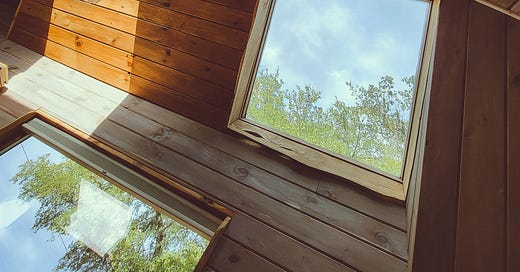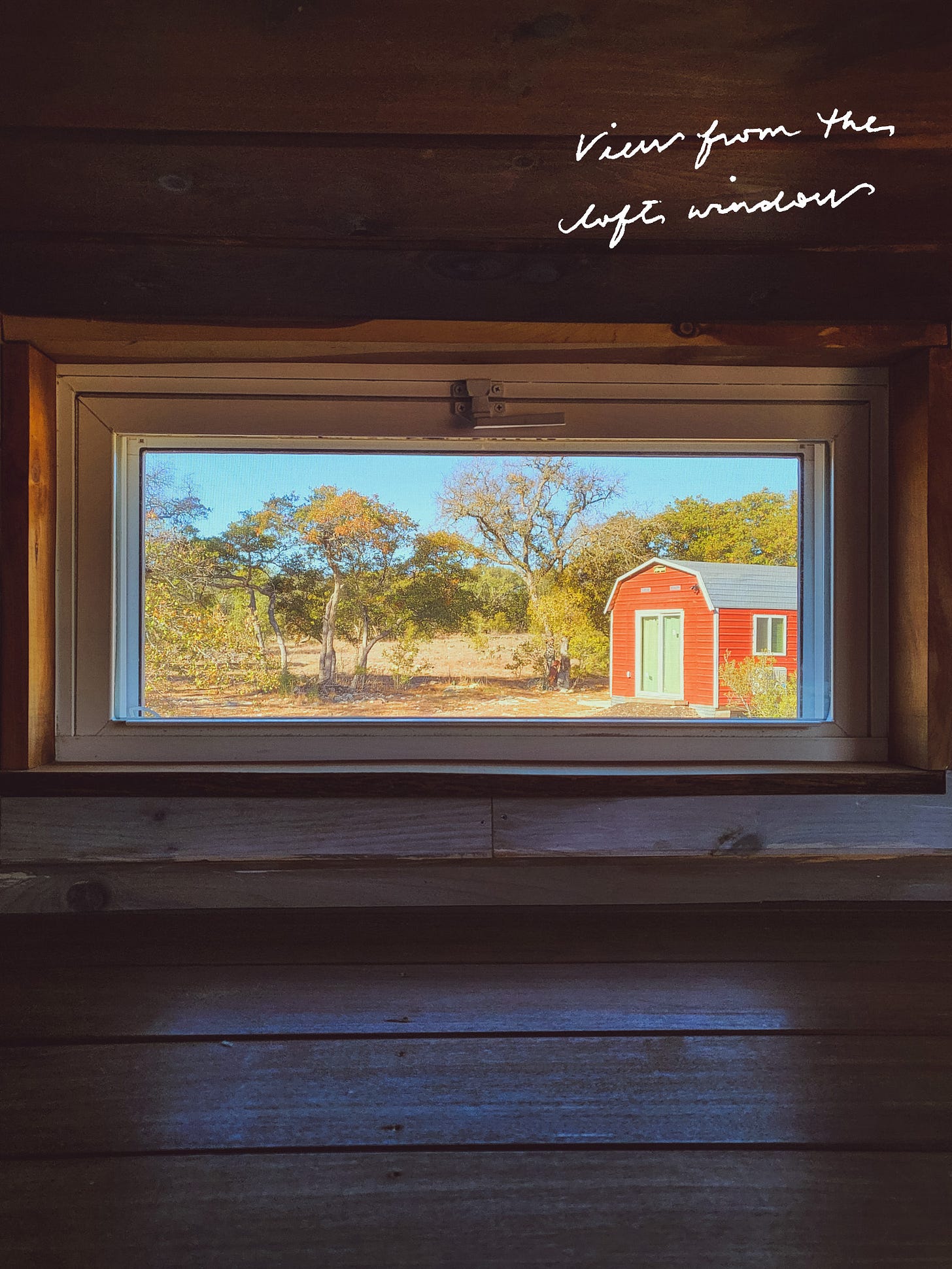Having grown up in a relatively quiet neighborhood in Metro Manila, I had two primary environmental considerations: the weather—Is it raining? Are there leaks in the house, risk of flooding outside? How hot will it be today?—and the traffic. Carrying a handheld fan, umbrella, a handkerchief, a light jacket, and a fighting spirit at all times would cover most weather scenarios year-round.
Now, being in a country with four seasons introduced me to a myriad of other concerns that living in a tiny home on a ranch intensified. During hurricane season, strong gusts and rain can rattle the house. Hearing the wind’s whistle accompanied by occasional shaking was unnerving at first, but anxiety about the home’s stability was soon soothed by a better understanding of its structure. The house weighs over 12,000 pounds and is stabilized on eight points—it would take a tremendously powerful storm, which would batter even most ordinary homes, for the structure to be seriously damaged. The shaking often dissuades people from living on wheels, but we’ve greatly reduced it by using wheel chocks and supporting the trailer with hollow blocks.
Winter, while generally mild in Central Texas, can be brutal on areas unprepared for the occasional subzero weather. In our case, we lost water on particularly frigid days due to a malfunctioning heated hose and an insufficiently insulated water source. The house comes with a 25-gallon water tank that would have served as our back-up, but there seems to be a tripped circuit disabling the pump from activating that we still need to figure out. If I wanted to use our washer/dryer in freezing temperatures, I would have had to winterize it, a process that requires the use of something called antifreeze (I decided to just rely on the nearby laundromat during this period). We were also warned about the risk of wild animals seeking warmth and refuge under the trailer during this season, so we made sure to complete our skirting before temperatures dropped last October.
Thankfully, weather here is more pleasant than not. Our tiny home has two skylights that, on beautiful, sunny days, allow warmth and light to fill the space. In the daytime, I never have to switch on any lights, and during the milder days of winter, we were able to get away with turning off our mini-split by relying on the sun to warm up the house in the day, and the walls’ insulation to keep it comfortable during the night. A small fireplace would have been a nice feature, but, given where we live, foregoing it was a reasonable compromise.
In the summer, conserving energy is a primary concern. Cooling the house, because of its size, doesn’t require much power, but the windows and skylights let in a lot of heat, making the inverter work much harder. For better thermal regulation, we plan to install blinds on our skylights before April. We also rely on a small fan at the loft to circulate the cool air from below, as the warm air gathers at the top of the house where we sleep. While the summers back home are different from the fierce, dry heat in Texas, coping with hot weather is a more familiar condition.
With the downsizing and ingenuity that come with going tiny, being more conscious about sustainability is a common byproduct of adopting this lifestyle. In my case, I was already drawn to a life of slowness—the only mode true sustainability can thrive in—so tiny home living has been a dream of mine for years now. Unlike apartment living, where so much of what goes in and out is invisible, tiny home living brings everything to the forefront. It’s hard not to be conscious about my water consumption given the ongoing drought in Texas, which has created one of the driest years in the state in over a century. There is a creek that supposedly runs through the ranch, but I have not seen it fill with water since we moved in August. Knowing, too, that all our wastewater ends up in the property’s drain field a quarter of a mile away inspires me to be highly conscious of the substances that go down our drains, as I can directly see the land I impact with every wash. All that water eventually seeps into the earth, and finds it way into the grass that the grazing goats feed on, and into the groundwater that our well draws from. The speed at which we fill up our small garbage bin with the plastic waste from our groceries constantly reminds us that our reliance on disposables needs significant improvement, and strengthens the case for growing our own food, fresh and package-free.
This shift in focus soon changed my relationship with certain belongings. Pens I’ve collected over the years—event freebies with surprisingly good ink, forgotten extras from boxed sets, novelty pieces received as gifts—have become clutter, together with the stack of old stationery and special paper that once gave me a sense of security. My downsized wardrobe, despite my initial resistance, proves that with well-made basics and resourcefulness, I don’t really need more than two drawers.
With this heightened eco-conscious mindset, Michael and I have slowly honed the art of make-do. We have challenged ourselves to first seek solutions from the tools already available to us rather than simply turning to the store for what we need. In figuring out our skirting, for example, we spent almost three months weighing the pros and cons of existing options—vinyl, foam boards, scrap wood, AirSkirts, custom skirts—based on cost, function, and convenience. Favoring affordability, our first attempt was to use scavenged scrap wood from our landlord’s toolshed, but the result was aesthetically shabby, functionally useless, and, with the use of untreated wood, possibly risky. The concession was to purchase wooden lattice from Lowe’s, which are specially manufactured for exterior use, and use the scrap planks to build the skirting frame. Elegant and cost-effective, the final output was highly satisfactory and fulfilling to complete ourselves. For good measure, we also stapled a layer each of metal wire mesh and landscape fabric at the back of the lattice to prevent small critters from crawling through the gaps.
In the same vein, when we need new furniture or storage solutions, our first instinct now is to reconfigure or repurpose what we already have, like packing all our extra bags inside a suitcase to save space, or installing an old metal hook on the leg of our folding table where I can hang my purse or tumbler, which might otherwise occupy valuable table or chair space. As tempting as it may be to buy uniform spice containers, stylish glass vases, or bamboo organizers, making do with what we have has worked perfectly well so far.
There are many more practices I am eager to realize, like growing a vegetable garden, regularly baking my own bread, or achieving zero-waste, but the reality of sustainable, long-term change, I’ve learned, is that it comes from small but sure steps. A life must and will be lived regardless of the failure or success to measure up to certain standards, and I no longer want to stretch myself beyond the present.
It is clear that the distance between my daily actions and their corresponding environmental footprint has narrowed, and this experience has, like magic, transformed my understanding of sustainability from something theoretical and academic into a knowledge that is lived, intimate, and immediate. The place I live in is beautiful: At night, the surroundings are so dark and quiet that I can stargaze with ease. Many mornings I wake up to the sound of birds and soft sunlight entering through the loft windows. When my mood is low, an afternoon walk never fails to lift the spirits. This place is so beautiful that I want to keep getting to know it—how to read the fast-rolling clouds and the texture of the soil, how to appreciate the beauty and role of insects, the names of all the trees and bushes, the footprints of the wildlife I know are around me but rarely see. Even when mud sticks to my shoes, or when horseflies hover by the door waiting for an opening, or when ice crawls on the windowpane, I want to know this place. I want to be in it like a wildflower.








